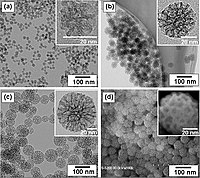
Photo from wikipedia
Abstract Homogeneous rapid sintering of nanoparticle powder compacts of yttria-stabilized zirconia was achieved by the radiation heat transfer. Green bodies were prepared by cold isostatic pressing (CIP) at various pressures… Click to show full abstract
Abstract Homogeneous rapid sintering of nanoparticle powder compacts of yttria-stabilized zirconia was achieved by the radiation heat transfer. Green bodies were prepared by cold isostatic pressing (CIP) at various pressures providing different porosity of samples before sintering. Pressure-less sintering was performed in air at a heating rate of 100 °C/min up to the 1500 °C/1 min. Scanning electron microscopy, mercury intrusion porosimetry, and Archimedes technique were used to characterize the microstructure and to determine the density of the green and sintered bodies. Contrary to expectations, our results reveal opposite dependence of the green- and sintered densities on the CIP pressure. Since the whole sintering process does not exceed 10 min, to propose what processes are responsible for observed results, our attention is focused on the radiation heat transfer from furnace heating elements into the ceramics. Our arguments are supported by numerical calculations of the electromagnetic field enhancement in/between particles.
Journal Title: Journal of The European Ceramic Society
Year Published: 2017
Link to full text (if available)
Share on Social Media: Sign Up to like & get
recommendations!